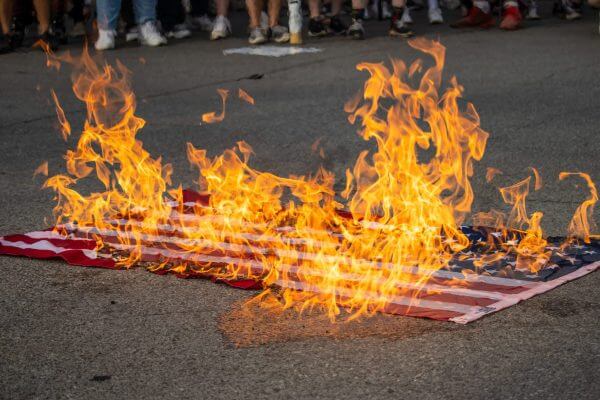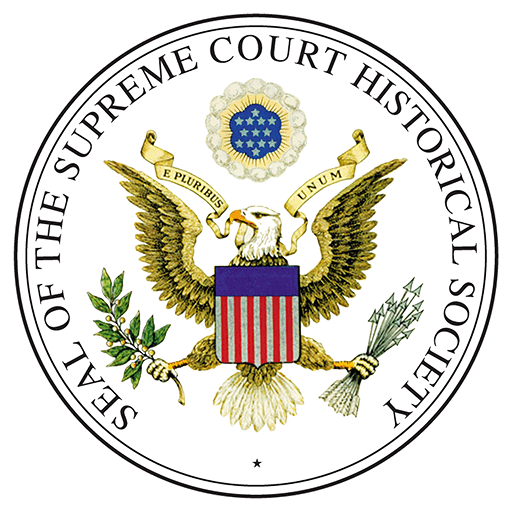
Schenck v. United States (1919)
Free Speech is Not Absolute in Times of War
A Socialist anti-war rally against World War I in Union Square, New York City, 1914
Photo Credit: Photo via Library of Congress Prints and Photographs Division Washington, public domain
Overview
During World War I, the United States instituted a military draft to build the military force it needed to succeed in the war. In 1917, the United States passed the Espionage Act making it a “...crime to cause insubordination, disloyalty, mutiny, refusal of duty, in the military” or to obstruct military recruiting.
Soon after the United States entered the war, Charles T. Schenck, a prominent member of the Socialist Party was arrested for mailing out 15,000 flyers encouraging draft-age men to sign petitions and actively engage against the military draft by raising their voices to Congress and the president. Schenck believed he was exercising his right to free speech by encouraging people to use their right to petition the government. In 1917 he was convicted of violating the Espionage Act and sentenced to 10 years in prison. The Supreme Court reviewed his case in 1919, upholding his conviction and the constitutionality of the Espionage Act.

A Socialist anti-war rally against World War I in Union Square, New York City, 1914
Photo Credit: Photo via Library of Congress Prints and Photographs Division Washington, public domain
"We admit that in many places and in ordinary times the defendants in saying all that was said in the circular would have been within their constitutional rights. But the character of every act depends upon the circumstances in which it is done . . . . The most stringent protection of free speech would not protect a man in falsely shouting fire in a theatre and causing a panic . . . . The question in every case is whether the words used are used in such circumstances and are of such a nature as to create a clear and present danger that they will bring about the substantive evils that Congress has a right to prevent."
- Justice Oliver Holmes, writing for a unanimous Court
Learning About Schenck v. United States
Students
This section is for students. Use the links below to download classroom-ready .PDFs of case resources and activities.
About the Case
Full Case Summaries
A thorough summary of case facts, issues, relevant constitutional provisions/statutes/precedents, arguments for each side, decision, and case impact.
Case Background and Vocabulary
Important background information and related vocabulary terms.
Learning Activities
Teachers
Use the links below to access:
- student versions of the activities in .PDF and Word formats
- how to differentiate and adapt the materials
- how to scaffold the activities
- how to extend the activities
- technology suggestions
- answers to select activities
Learn more about Street Law's commitment and approach to a quality curriculum.
About the Case
- Full Case Summaries: A summary of case facts, issues, relevant constitutional provisions/statutes/precedents, arguments for each side, decision, and impact. Available at high school and middle school levels.
- Case Background: Background information at three reading levels.
- Case Vocabulary: Important related vocabulary terms at two reading levels.
- Diagram of How the Case Moved Through the Court System
- Case Summary Graphic Organizer
- Case Summary Graphic Organizer - Fillable
- Decision: A summary of the decision and key excerpts from the opinion(s)
Learning Activities
After the Case
- Cartoon Analysis
- Applying Precedents: Snyder v. Phelps (2011)
Teacher Resources
Teaching Strategies Used
Planning Time and Activities
If you have ONE day...
- Read the background summary (•••, ••, •) and answer the questions.
- Complete the Classifying Arguments Activity. Discuss which arguments the students find most convincing.
- For homework, have students read the Key Excerpts from the Opinion and answer the questions. Follow-up the next day by reviewing the questions with students.
If you have TWO days...
- Complete the activities for the first day (excluding the homework).
- Complete the Judicial Opinion Writing Activity
- For homework, have students read the Key Excerpts from the Opinion and answer the questions. Follow up the next day by reviewing the questions with students.
If you have THREE days...
- Complete the activities for the first and second days (excluding homework).
- Have students read the Key Excerpts from the Opinion and answer the questions. Complete the Advertisement Analysis Activity
If you have FOUR days...
- Complete the activities for the first, second, and third days.
- Complete the Political Cartoon Analysis
- Complete the Applying Precedents Activity: Snyder v. Phelps (2011).
Glossary
These are terms you will encounter during your study of Schenck v. United States. View all Glossary terms here.
Related Cases
Legal Concepts
- These are legal concepts seen in Schenck v. United States. Click a legal concept for an explanation and a list of other cases where it can be seen. View all Legal Concepts here.




